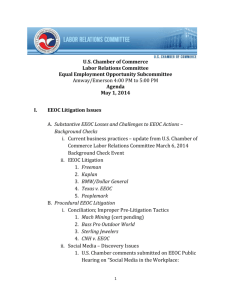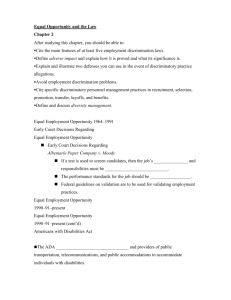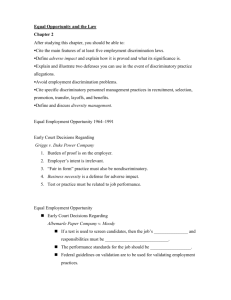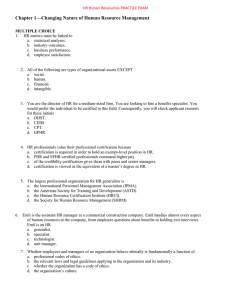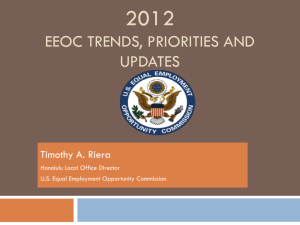here - Office of Equal Opportunity
advertisement
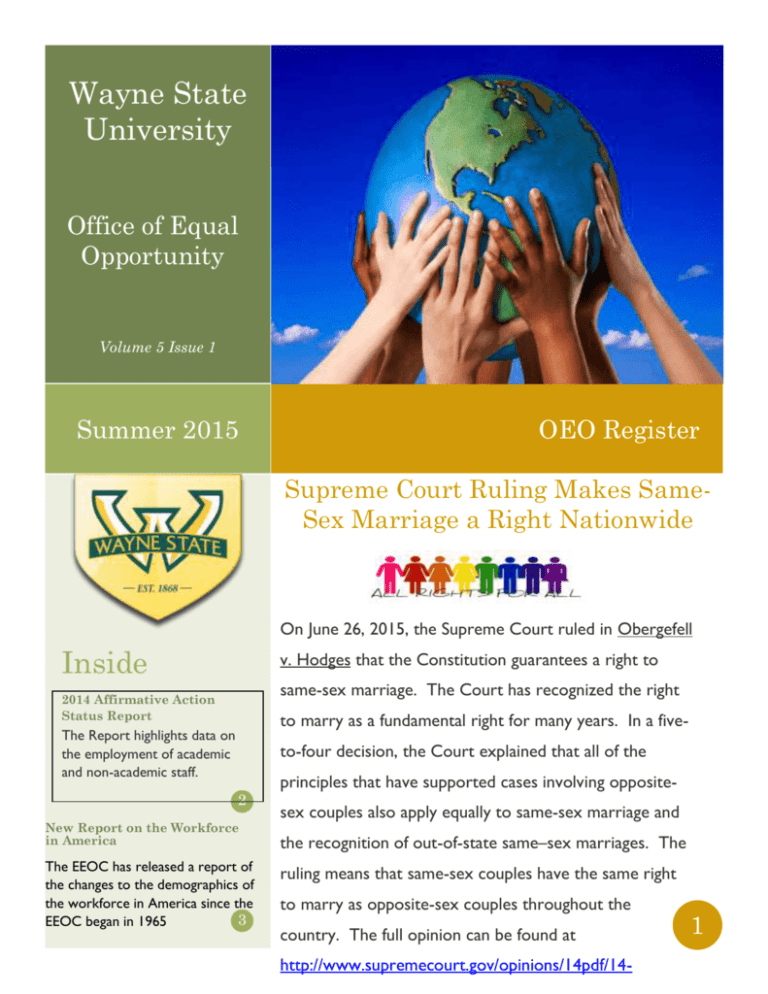
Wayne State University Office of Equal Opportunity Volume 5 Issue 1 Summer 2015 OEO Register Supreme Court Ruling Makes SameSex Marriage a Right Nationwide On June 26, 2015, the Supreme Court ruled in Obergefell Inside v. Hodges that the Constitution guarantees a right to same-sex marriage. The Court has recognized the right 2014 Affirmative Action Status Report to marry as a fundamental right for many years. In a five- The Report highlights data on the employment of academic and non-academic staff. to-four decision, the Court explained that all of the 2 New Report on the Workforce in America The EEOC has released a report of the changes to the demographics of the workforce in America since the 3 EEOC began in 1965 principles that have supported cases involving oppositesex couples also apply equally to same-sex marriage and the recognition of out-of-state same–sex marriages. The ruling means that same-sex couples have the same right to marry as opposite-sex couples throughout the country. The full opinion can be found at http://www.supremecourt.gov/opinions/14pdf/14- 1 2014 Affirmative Action Status Report The Affirmative Action Status Report for 2014 (Report) was presented at the meeting of the WSU Board of Governors on June 26, 2015. The Report highlights data on the employment of academic and nonacademic staff (with an emphasis on the representation of women and minorities), processing of discrimination and harassment complaints, and the university’s efforts at supplier diversity. The majority of WSU employees are women and over 40% of employees identify themselves as minorities. 2 During 2014, there were 25 formal complaints filed with the OEO, which include complaints filed with the OEO under the WSU non-discrimination and harassment policies and complaints filed with outside agencies. Of the 17 formal complaints that were closed in 2014, 16 of the complaints were closed without a finding of a violation of University policy or federal/state law. The Report also contains a section comparing WSU and other Michigan Public Universities and peer institutions. The Report is available on the OEO website at http://oeo.wayne.edu/resources/report s.php. New Report on the Workforce in America As part of the celebration of its 50th Anniversary, the EEOC has released a report of the changes to the demographics of the workforce in America since the EEOC began in 1965. In American Experiences versus American Expectations, the EEOC reviews changes in participation between 1966 and 2013 for African-Americans, Hispanic, Asian-Americans, American Indians/Alaskan Natives and women in nine job categories. Some notable items from the report include the following: U.S. Equal Employment Opportunity Commission The Federal Laws enforced by EEOC include: Title VII of the Civil Rights Act of 1964 The Equal Pay Act of 1963 The Age Discrimination 1967 Title I of the Americans with Disabilities Act of 1990 Sections 501 and 505 of the Rehabilitation Act of 1973 The Pregnancy Discrimination Act In 1966, African-Americans, Hispanics, and AsianAmericans each made up less than 1 percent of senior-level positions. Since then, the participation rates for all three groups have increased by five to seven times. The participation rate of women in the Professionals category has skyrocketed from roughly 14 percent in 1966 to more than 53 percent in 2013. Women and minorities remain concentrated, or segregated, in lower paying positions. For example, in 2013: Hispanics composed 20.5 percent of Service Workers and 29.2 percent of Laborers, yet they were only 5.7 percent of Professionals and 7.4 percent of Officials and Managers. African-Americans composed 23.3 percent of Service Workers and 18.7 percent of Laborers, yet they were only 7.6 percent of Professionals and 6.8 percent of Officials and Managers. The report is available at http://www.eeoc.gov/eeoc/statistics/reports/american_expe riences/. 3 The Office of Equal Opportunity is the Wayne State University office that is responsible for the implementation of the University's NonDiscrimination / Affirmative Action policies, procedures and practices to ensure that no person is discriminated against in employment, educational programs and activities on the basis of race, color, sex (Including gender identity), national origin, sexual orientation, marital status, height, weight, disability or veteran status. Services that OEO provide to the University community include, but are not limited to: Affirmative action and equal opportunity program planning Americans with Disabilities Act monitoring and compliance Veterans Administration reporting Search committee liaisons and employment search committee training University employment action monitoring Conflict resolution and mediation Anti-discrimination, diversity and sexual harassment seminars The Office of Equal Opportunity is also the department that develops and monitors the WSU Supplier Diversity Program which promotes the University's commitment to doing business with minority and women entrepreneurs and small businesses. Historical News Wayne State University Office of Equal Opportunity 656 W. Kirby Ste. 4321 F/AB Detroit MI 48202 Phone: 313 - 577-2280 Fax: 313-577-7738 On July 2, 1964, U.S. President Lyndon B. Johnson signed into law the historic Civil Rights Act in a nationally televised ceremony at the White House. In the landmark 1954 case Brown v. Board of Education, the U.S. Supreme Court ruled that racial segregation in schools was unconstitutional. The 10 years that followed saw great strides for the African-American civil rights movement, as nonviolent demonstrations won thousands of supporters to the cause. As the strength of the civil rights movement grew, John F. Kennedy made passage of a new civil rights bill one of the platforms of his successful 1960 presidential campaign. As Kennedy’s vice president, Johnson served as chairman of the President’s Committee on Equal Employment Opportunities. After Kennedy was assassinated in November 1963, Johnson vowed to carry out his proposals for civil rights reform. The Civil Rights Act fought tough opposition in the House and a lengthy, heated debate in the Senate before being approved in July 1964. The most sweeping civil rights legislation passed by Congress since the post-Civil War Reconstruction era, the Civil Rights Act prohibited racial discrimination in employment and education and outlawed racial segregation in public places such as schools, buses, parks and swimming pools. In addition, the bill laid important groundwork for a number of other pieces of legislation–including the Voting Rights Act of 1965, which set strict rules for protecting the right of African Americans to vote.

